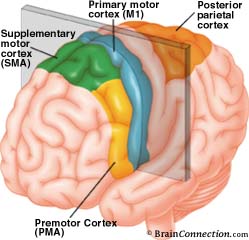Primary motor cortex
From Psy3242
The primary motor cortex, also known as the motor strip, M1, F1, or Brodmann's Area 4, is one of the principal brain areas responsible for motor function and the execution of movements. It is located in the rear portion of the frontal lobe of the brain, before the central sulcus that separates the frontal lobe from the parietal lobe and along a bump called the precentral gyrus. M1 is only part of the complete motor cortex, which is also made up of the premotor area (PMA) and the supplementary motor area (SMA) of Area 6, but it includes the cortico-spinal and the cortico-bulbar pathways and the axons of pyramidal neurons.
The motor strip is highly topographical in its organization, and every part of the body is represented, though the relationship between cortical 'space' in the motor strip and body region is not proportionate. Body areas capable of fine motor control - such as the hands and fingers and the mouth area of the face - are over-represented, and there is under-representation of less 'movement-critical' regions such as the back and top of the head, the trunk or torso of the body, and the upper limbs. The amount of brain matter in M1 devoted to each particular body part represents the amount of control that it has over that body part. The disproportionate nature of the body's representation is displayed in a map called the motor homunculus (featured below).
The primary motor cortex is predominantly contralateral in its control over the body. The right motor cortex coordinates and manages muscles in the left side of the body, and the left motor cortex coordinates the right side of the body. Signals from M1 cross the body's midline to activate skeletal muscles on the opposite side of the body.
History
In 1870, Hitzig and Fritsch electrically stimulated different parts of a dog's motor cortex. They observed that depending on where they applied stimulation, various parts of the body contracted. When they destroyed the same small area of the cortex, the dog experienced permanent paralyzation in the corresponding body part. Hitzig and Fritsch became the first to come to the conclusion that every part of the body has a particular region of the primary motor cortex devoted to its movement.
Interesting fact:
The motor cortex is responsible for movement, foot tapping, dancing and playing an instrument while the auditory cortex is responsible for the first stages of listening to sounds, and the perception and analysis of tones.


